As food bloggers, one of the most important things we do is… well, write recipes, of course!
And a lot goes into the recipe writing process: coming up with ideas for new recipes, testing a recipe until it’s perfect, writing down the instructions in a concise way, formatting the recipe on a blog post, and so on.
The more you create recipes, the more you’ll perfect your process, but in this post, we wanted to share some common recipe writing mistakes we see bloggers make. Hopefully you’ll be able to learn a thing or two to help level up the recipes that you share online!

Mistake #1: Not Testing Recipes Enough (or Properly!)
Picture this: You baked a delicious triple-layer chocolate cake last weekend that turned out absolutely perfect. But when you make the recipe again this week to share it on your blog, it’s a complete fail. The cake tastes dry and crumbly, and you’re not sure what you did differently the second time.
That’s why it’s so important to test your recipes! Before you even put pen to paper, recipe testing is one of the most crucial things you’ll do.
Testing a recipe helps ensure that the recipe works, that the ingredient amounts are correct, that the instructions are easy to follow, and that the recipe yields a consistent result every time it’s made. And most importantly, it helps to make sure that your readers end up with a delicious result!
We recommend testing your recipes at least two to four times before sharing them online, but keep in mind that every recipe is different. You want to test each recipe as many times as needed until it’s perfect, and sometimes that might be more than four times.
One last tip when it comes to testing recipes: When testing your recipe, be sure to only change one ingredient or step at a time. This lets you know exactly what effect making that change had. For instance, in one test, you might tweak the amount of salt in the recipe, whereas in the next test, you might increase the cooking time.
Want to learn even more about recipe testing?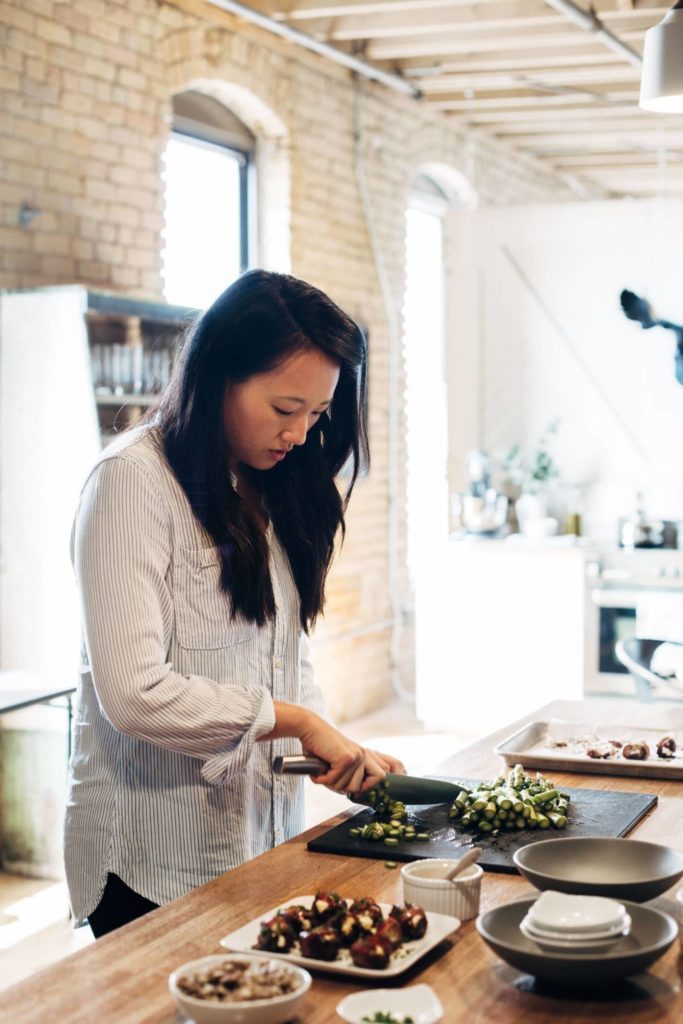
Mistake #2: Not Listing Ingredients in the Order They’re Used
This is a short and easy one, but as a best practice, it’s recommended that you list ingredients in the order they’re used when writing a recipe. This lets your readers follow the recipe in a progression from top to bottom, and it helps make the recipe as clear as possible.
Before you publish a recipe on your blog, double-check how you’ve written the ingredients and instructions to see if you’ve done this! If you’re not already writing your ingredients like this, it’s a super simple switch to make, and I bet your readers will thank you later. 😊
Mistake #3: Not Being Specific Enough in the Recipe Instructions
When writing recipes, it’s important to be as specific as possible. When someone makes your recipe at home, you don’t want them to have any confusion when they start the cooking process.
There are many different areas in a recipe where you want to be as specific as possible, including:
- Ingredients: Be sure to list precise amounts for all ingredients needed to make the recipe (including small ingredients like salt and pepper).
- Cook Time: It’s important to accurately write the time needed to make the recipe. If applicable, be sure to include prep time and chill time as well!
- Yield: After making the recipe, calculate the amount that it yields, and be sure to include this information in the recipe card. Instead of writing, “Yields 12 servings,” try to be a bit more specific and write something like, “Yields 12 2-inch slices.”
- Tools and Equipment: When writing the instructions for a recipe, be sure to clarify what type of tool or cooking equipment should be used for each step.
- Doneness: Instead of writing “Cook until done,” aim to provide a length and indicator of doneness for the recipe. Here’s a good example: “Bake for 15 minutes, or until the chicken is crispy and cooked to an internal temperature of 165 degrees Fahrenheit.”
The more specific you are when writing a recipe, the more success your readers will have recreating it!
Mistake #4: Not Offering Substitutions
If you’ve published a recipe online, chances are you’ve seen a comment or two like this before:
I made this recipe the other day but didn’t have milk in my fridge, so I used almond milk instead, and the muffins turned out SO dry. Major fail.
While we can’t always prevent our readers from substituting every ingredient in the recipe, we can offer substitutions when possible. However, be sure to test any substitutions before recommending them for a particular recipe!
There are many different places you can add substitution suggestions within your posts. You can write them on the ingredients list or notes section of the recipe card, or you could add a dedicated section with its own heading for substitutions within the blog post itself.
Here’s an example of a substitution suggestion for a recipe from our sister site, Pinch of Yum:
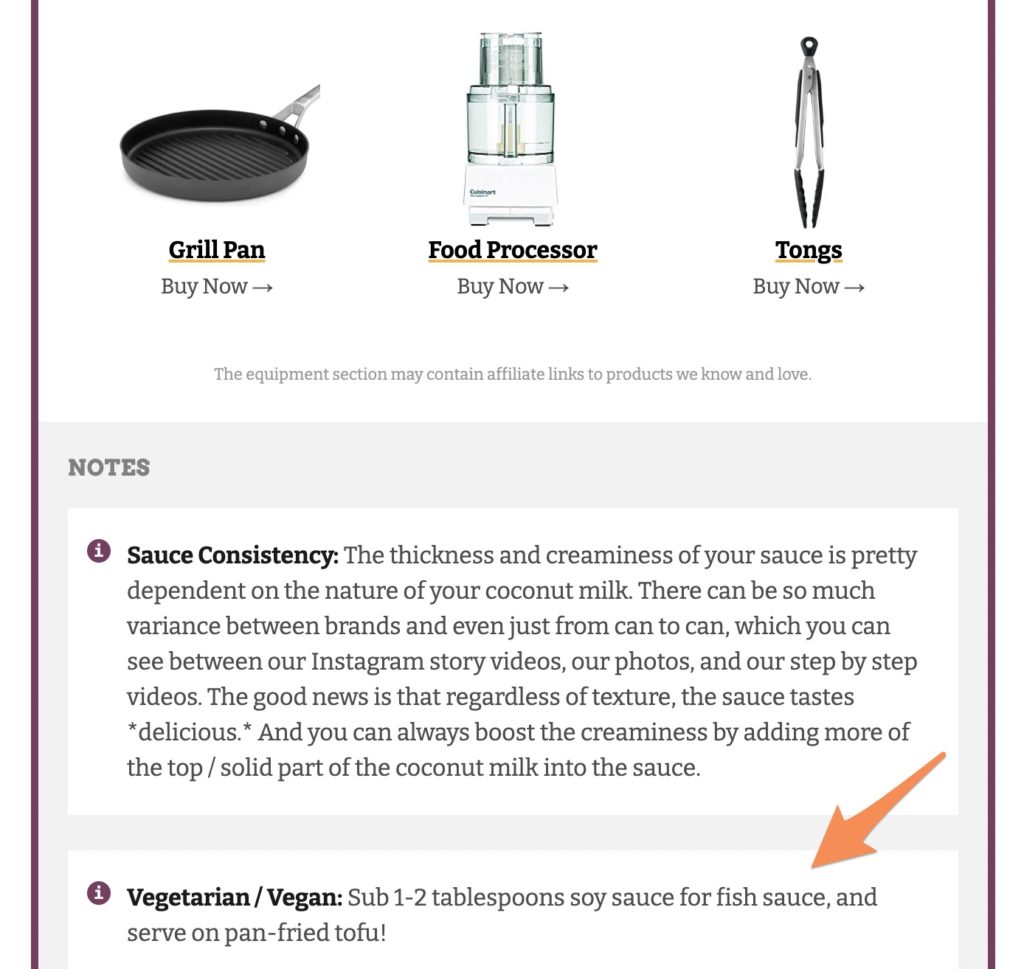
It doesn’t take long to write out a few substitution ideas for each recipe, and your readers will undoubtedly appreciate having the information handy.
Mistake #5: Not Offering Storage Suggestions
Chances are your readers might not be able to eat all the portions of an entire recipe in one sitting when they recreate it at home. That’s why it’s so important to share storage suggestions for your recipes!
You can include these storage instructions either at the bottom of the instructions list or in the notes section of the recipe card. It can be helpful to include information like:
- Should leftovers be refrigerated, or can they stay at room temperature?
- How long will the leftovers stay fresh?
- Can you freeze leftovers? For how long?
- What container should be used to store leftovers?
- If applicable, how should the leftovers be warmed up again later?
You don’t have to go crazy when writing storage suggestions for each recipe! A little information goes a long way. And if you’re looking for an overview of how long different types of food can be stored, we recommend referencing this handy guide as a starting point.
Mistake #6: Not Attributing Recipes Properly
When you come up with a new idea for a recipe, you most likely found inspiration for that recipe from somewhere. Maybe you’re recreating your favorite linguine recipe from the Italian restaurant down the street, or perhaps you’re getting inspiration from another blogger’s chili recipe.
In all of these cases, it’s important to give credit where credit’s due. When you publish the recipe on your site, we recommend including a complimentary mention of the original source (in the blog post and/or in the recipe card), as well as a link back to that source.
Here’s an example of recipe attribution from Pinch of Yum:
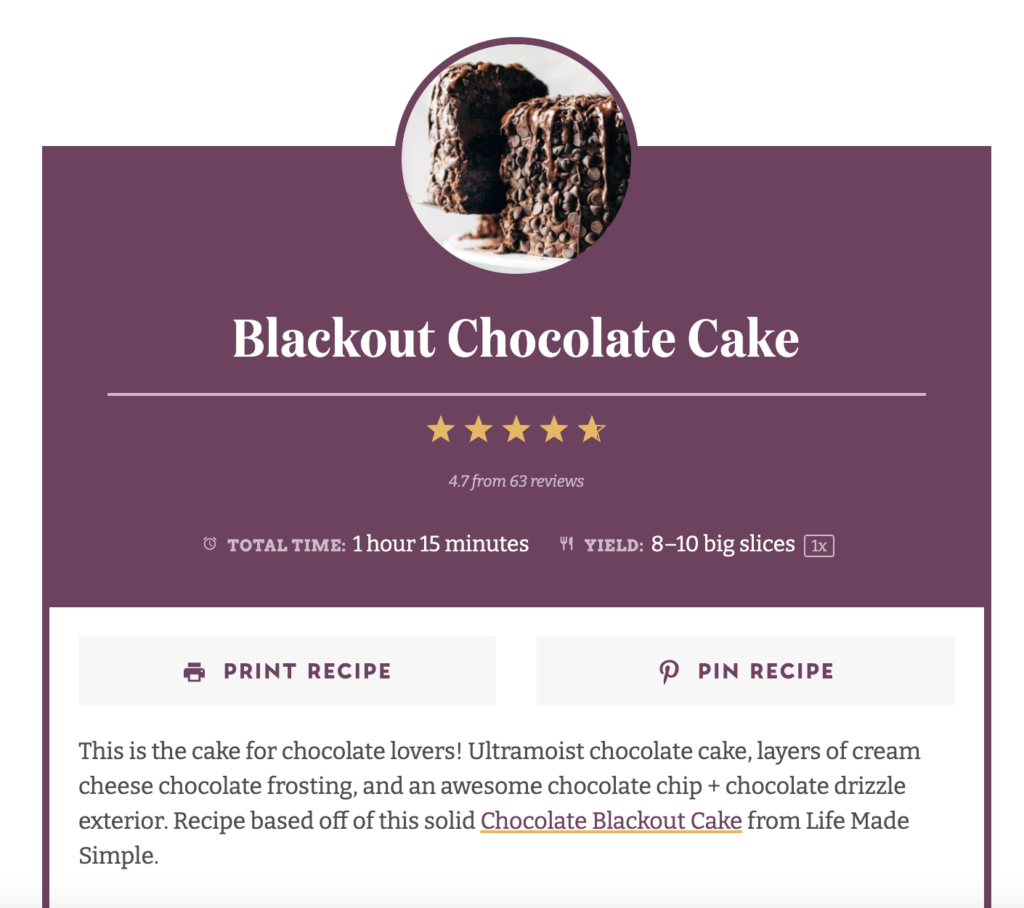
There are a lot of considerations to keep in mind when attributing recipes, so to learn more about this topic, we recommend checking out this blog post.
Mistake #7: Not Using a Recipe Plugin
Last but not least, if you’re using WordPress to run your food blog, you’ll want to make sure you’re using a recipe plugin. Recipe plugins help format your recipes in a visually appealing way, and they also add special code to your recipes that help search engines understand the content and display it in search results.
Here are a few examples of what recipe plugins look like in action:
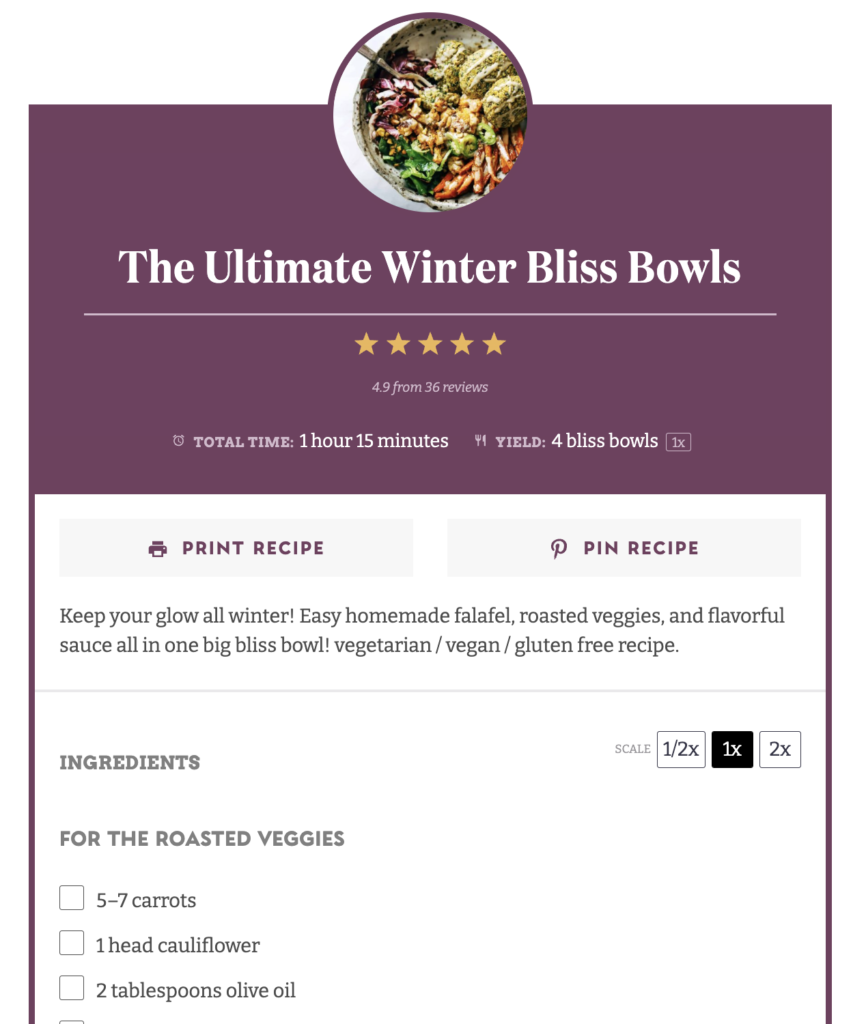
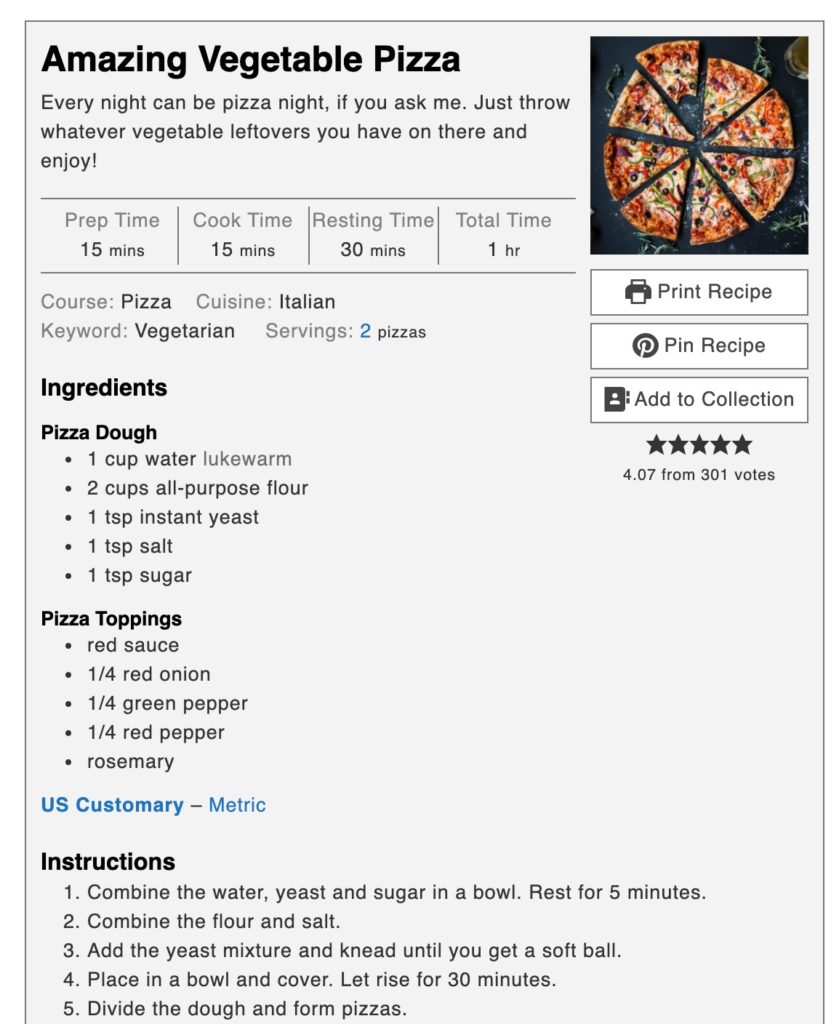
While there are tons of recipe plugins on the market, some of the most popular ones used by food bloggers are:
If you’re not using a recipe plugin yet and you’re unsure where to get started, this post goes over how recipe plugins work and walks you through how to choose the best recipe plugin for your site.
Want to dive even deeper into the world of recipe plugins?And that’s a wrap on this post all about recipe writing mistakes! We hope that you found this post helpful and that it gave you a few factors to consider when sharing recipes on your blog.
Like anything else, recipe writing is a skill that you’ll develop and nurture over time, and with each recipe you create, you’ll continue to learn and improve your process. Looking for how to write even better recipes? Don’t miss this blog post: 7 Ways to Write Better Recipes as a Food Blogger!
Now let us know in the comments: What are some of your best tips when it comes to writing recipes? Have you made any of these mistakes before?
Spot On Leslie, and I would suggest adding these three additional mistakes as well:
Mistake #8: Not Including Accurate Cooking/Baking Times and Temperatures
Mistake #9: Not Providing Adequate Visuals or Photos to Illustrate the Recipe
Mistake #11: Not Considering Dietary Restrictions and Allergies in Recipe Development.
Hi Hamphrey! I couldn’t agree more – those are definitely common mistakes that can be so frustrating when you’re trying to prepare a recipe at home!
Thank you so much for this well-written blog. It was a really great help!
So glad to hear you found it helpful! Thanks, Deepak!
I agree with the idea of writing down all of the ingredients needed to make the recipe. Just one missing piece could totally change the taste of the dish. This is why my friend always wants pens around her commercial kitchen. So she could write stuff like this when inspiration strikes.
Exactly! Kind of like the concept of leaving a notebook and pen on your bedside table! You never know when inspiration will strike.
They always post in metrics instead of the English alternative next it in parens.
Great insights, Leslie! I completely agree that testing recipes is crucial for consistency. Have you found any specific testing methods that work best for you? Thanks, you Leslie
Thank you so much! I totally agree—testing can really make or break a recipe’s success. I’ve found that testing at least 2–3 times with slight tweaks (especially to cooking time or ingredient ratios) helps me dial things in. I also try to have someone else make the recipe to see if the instructions are clear. Do you have a go-to method for testing your recipes?
Great insights! These 7 mistakes are spot on—especially the importance of clear instructions and consistent measurements. It’s a helpful reminder for all food bloggers to focus on clarity and user experience. Thanks for the valuable tips and guidance!
Happy you found these tips helpful – clarity and user experience are always going to be SO important!